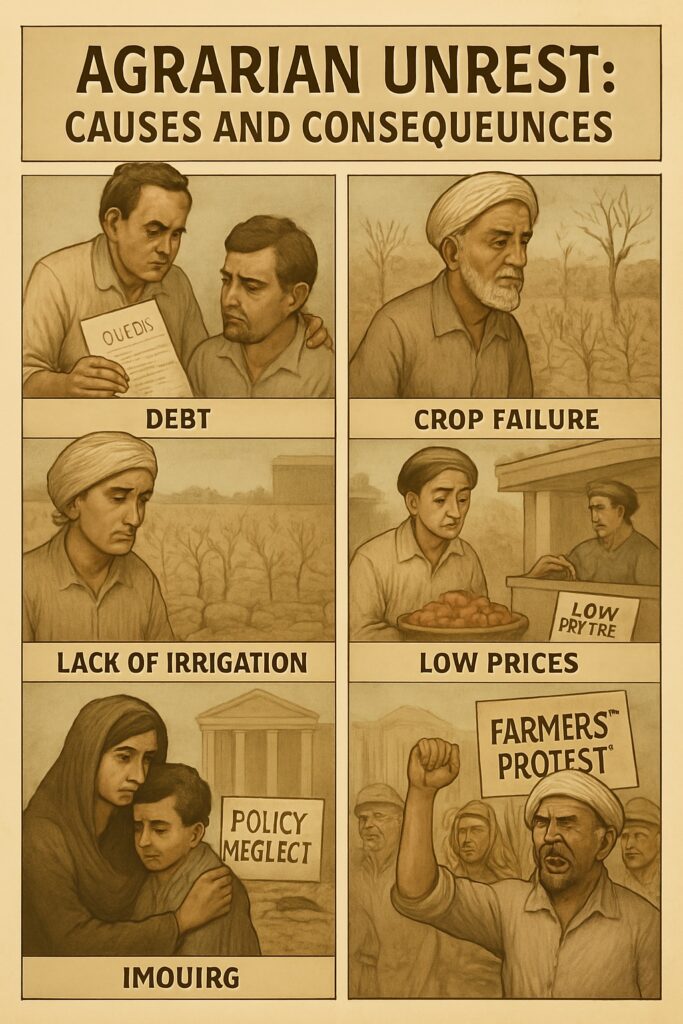Agrarian and industrial unrest refers to the conflicts, strikes, protests, or dissatisfaction expressed by farmers and industrial workers due to economic hardship, poor working conditions, or government policies. These forms of unrest highlight deep-rooted issues in India’s agricultural and industrial sectors, which are vital to the country’s economy and social stability.

Table of Contents
What is Agrarian Unrest?
Agrarian unrest is the dissatisfaction and agitation among farmers due to factors like debt, crop failure, low prices, lack of irrigation, and policy neglect. It can lead to farmers’ protests, suicides, and even social movements.
Causes of Agrarian Unrest
- Indebtedness
- High interest loans from informal sources trap farmers in debt cycles.
- Crop Failures and Natural Disasters
- Droughts, floods, and pests cause massive crop losses.
- Low Minimum Support Prices (MSPs)
- Farmers don’t receive adequate returns for their produce.
- Inefficient Procurement and Storage
- Poor infrastructure leads to post-harvest losses and exploitation.
- Land Fragmentation
- Small and uneconomic land holdings reduce profitability.
- Lack of Irrigation and Inputs
- Inadequate access to water, quality seeds, and fertilizers.
- Policy Issues
- Delayed payments, complicated subsidy systems, and lack of crop insurance awareness.
Recent Examples of Agrarian Unrest
- Farmers’ Protest (2020–2021): Large-scale protest against three farm laws, which were eventually repealed.
- Recurring Farmer Suicides: Especially in Maharashtra, Telangana, Punjab, and Karnataka due to crop failure and debt.
Effects of Agrarian Unrest
- Rural distress and migration
- Low agricultural productivity
- Loss of trust in governance
- Rise of farmer movements and political instability
What is Industrial Unrest?
Industrial unrest refers to conflicts between employers and workers in industries due to low wages, unsafe conditions, job insecurity, or violation of labor rights. It often results in strikes, lockouts, or slowdowns.
Causes of Industrial Unrest
- Low Wages and Poor Working Conditions
- Many workers are underpaid and lack basic safety and health measures.
- Job Insecurity
- Contractual employment and layoffs in both public and private sectors.
- Lack of Union Representation
- Suppression or weakening of labor unions in many industries.
- Long Working Hours and Exploitation
- Especially in the informal and unorganized sectors.
- Inequality and Disparities
- Huge income gaps between workers and corporate executives.
- Unfair Labor Practices
- Delay in payments, discrimination, and denial of legal rights.
Examples of Industrial Unrest
- Maruti Suzuki Manesar Plant (2012): Violent labor unrest due to wage disputes and union issues.
- Strikes in IT and manufacturing sectors: Demanding better working hours and fair compensation.
Effects of Industrial Unrest
- Loss of production and revenue
- Damage to industrial relations
- Decline in foreign and domestic investment
- Reduced worker morale and trust
Measures to Address Agrarian and Industrial Unrest
For Agrarian Unrest:
- Strengthen MSP and procurement system
- Expand crop insurance and credit access
- Encourage farmer producer organizations (FPOs)
- Invest in irrigation, storage, and market linkages
- Implement land reforms and digital record-keeping
For Industrial Unrest:
- Ensure fair wages and timely payments
- Improve working conditions and safety standards
- Strengthen labor unions and grievance mechanisms
- Promote skill development and job security
- Enforce labor laws transparently
Conclusion
Both agrarian and industrial unrest reveal systemic issues in India’s economic sectors. Farmers and workers form the backbone of the nation, and their problems demand urgent attention. Ensuring inclusive development, better labor and farm policies, and dialogue between stakeholders is crucial for maintaining economic growth and social harmony.
Read: Geography Notes